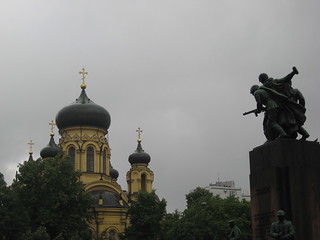Putting the Sleepers to Sleep
By Maryna Polataiko for postcommunistmonuments.ca
On November 18th 1945, a statue depicting seven soldiers was raised on Wileński Square in Warsaw. On a tall, tiered base: Three Soviet soldiers stand ready for combat. Below, four Polish soldiers—the ‘Four Sleeping Soldiers’—stand guard. Celebrating the defeat of Nazi Germany, the monument recognized the Soviet Red Army’s contribution to Poland’s independence. More broadly, the monument stood as a symbol for Soviet-Polish friendship. Yet the sleeping soldiers were not taken down following the collapse of the U.S.S.R.
Only in 2011 were they taken down temporarily due to construction work being done on Warsaw’s metro system. In line with a 1994 intergovernmental agreement concerning war memorials, Warsaw officials agreed to return the monument post-construction. Its return, however, was met with public opposition. Today, the soldiers represent an outdated and unwanted Communist presence, coupled with the reminder of Poland’s involuntary friendship with Russia.
In late February, Warsaw’s city council voted to hide the monument in a storeroom instead of returning it to Wileński Square. Amidst Polish-Russian tensions over Ukraine’s annexation, the decision to hide the monument is anything but apolitical.
Russia has accused Poland of a disrespectful attitude to the monuments to Soviet soldiers. Warsaw asserts that the conflict draws on different understandings of memory about WWII. An expert from the Polish Council says that in Poland, people commemorate the memory of those fallen in the war (there are 630 Soviet soldiers’ cemeteries in Poland, all of them maintained by the state), while Russia honors the monuments, which he calls “the monuments of fraternal arms,” fixtures erected during the period of Soviet control.
[SOURCES:]
http://www.nytimes.com/aponline/2015/02/27/world/europe/ap-eu-poland-soviet-monument.html
“Soviet Monument Banned From Returning to Warsaw Square.” The New York Times, February 27, 2015. Accessed March 15, 2015. http://www.nytimes.com/aponline/2015/02/27/world/europe/ap-eu-poland-soviet-monument.html?_r=1.
Filip Lech. “Comradeship of the Sad and the Fighting: A History of Vanishing Monuments.” Culture.Pl, February 17, 2015. Accessed March 1, 2015. http://culture.pl/en/article/comradeship-of-the-sad-and-the-fighting-a-history-of-vanishing-monuments.
“Soviet-Era Monument to Disappear from Warsaw Praga District.” Radio Poland, February 27, 2015. Accessed March 15, 2015. http://www.thenews.pl/1/9/Artykul/198554,Sovietera-monument-to-disappear-from-Warsaw%E2%80%99s-Praga-district.
http://www.radiosvoboda.org/content/article/26987441.html
Юрій Савицький. «Шанування пам'яті померлих чи культ радянських пам'ятників?» Радіо Свобода, May 3, 2015. Accessed May 3, 2015. http://www.radiosvoboda.org/content/article/26987441.htm.


